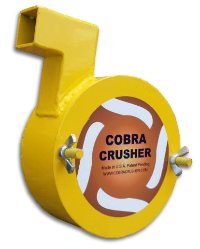Wouldn't it be nice if we all had access to geologists, drilling crews, and huge rock crushers to sample hardrock deposits? Well, if that's not in your budget but you still need to determine if an outcropping or vein might be promising before you stake a claim, a portable Cobra Crusher and a few grab samples can work nicely. A grab sample is just that -- randomly chosen rock samples you need to crush and test for gold or other precious metals.
Although grab samples can seem counter productive because of the randomness, they can still provide you with a basic, overall understanding of the area and the possibility of higher grade ores in the vicinity. When looking for a grab sample, choose mineralized portions of the vein, pieces of mine dumps near a portal or shaft, or chunks of mineralized float that have broken away from the vein. Mineralized quartz on a mine dump near a mine portal or shaft makes for good grab samples. Often the operators of small mines had to sort and ship only the best of the ore. That means high grade materials can be left behind in mine dumps.
What's especially great about the Cobra Crusher is that it's portable and light weight. You don't have to collect and then lug around heavy rocks and wait until you get back home or to your camp to know if they are worth anything. You can crush a few small rocks right in the field, then pan out the powder to see if its gold bearing. Having a small light-weight crusher with you in the field saves guess work. You'll know for sure right there and then if the site you've discovered is worth further consideration.
If you don't have water to pan the powder on the spot, crush the rock and store the powder in a plastic bag. Label the bag with GPS coordinates so you know EXACTLY where you got it. Then, after you've panned it later, if you find it contains a good bit of gold, you will know exactly where to return for further testing. It's also helpful to snap a photo of the place where you collected the rock. Matching the GPS coordinates with your photo ensures you'll be able to get back to that exact spot at a later date.
In addition to collecting rocks, you might want to take some chip samples from a wide vein. Use a rock hammer to break off small pieces and then run them through the Cobra Crusher. Again, pour the powder into a well labeled bag if you can't pan in the field and can wait until a later time to get the results.
When preparing for a sampling expedition, use the information on your local Bureau of Land Management website or in their office. In these files, geologists might have made notes about the specific mines in the area, and/or there will be details about the ore grade, tonnage and past production -- all good indicators so you don't waste your time. Mine maps can often be found in these files as well. You might be able to locate old stopes or mapped veins. This information can tell you where high grade ores were found in the past, which is where you might want to explore today.